【新】仁爱版八年级英语下册Unit8 Topic 2 SectionB优质课课件.ppt
仁爱版八年级下册Unit8Topic2SectionB教学设计
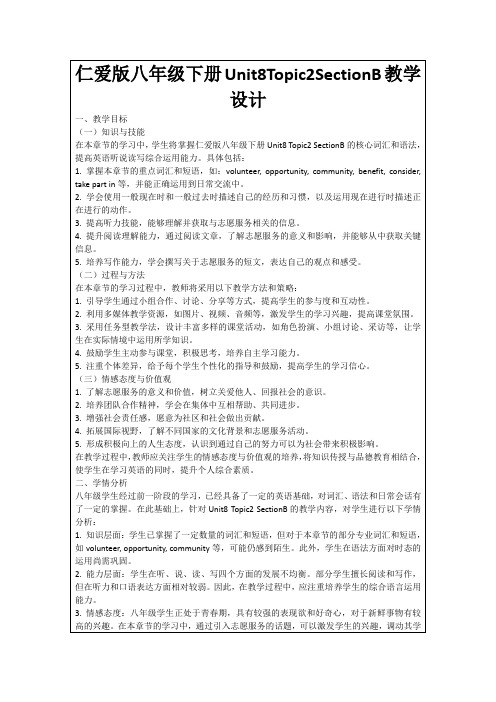
2.教学过程:
-教师提出问题:“What kind of volunteer service would you like to participate in? Why?”
-学生分组讨论,各小组成员发表自己的看法,并记录下来。
-各小组派代表汇报讨论成果,教师对学生的表现给予评价和指导。
2.语法练习:根据本节课学习的时态知识,完成课本P54的语法改错练习,提高学生对时态的掌握程度。
-教师设计一份包含一般现在时、一般过去时和现在进行时的语法改错题,要求学生认真完成。
-学生在完成练习的过程中,注意观察句子中的时态错误,培养自己的语法意识。
3.听力练习:完成课本P56的听力练习,提高学生的听力理解和信息捕捉能力。
-利用课堂时间进行即时反馈,纠正学生的错误,帮助他们及时改进。
-定期组织学生进行自我评价和同伴评价,培养他们的自主学习能力和批判性思维。
四、教学内容与过程
(一)导入新课
1.教学活动设计:
-教师以图片展示不同类型的志愿服务活动,如环保、敬老、支教等,引发学生对志愿服务的思考。
-通过提问方式,让学生分享他们对志愿服务的了解和看法,为新课的学习奠定基础。
2.教学过程:
-教师展示图片,引导学生观察并提问:“What are they doing? Do you know what volunteer service is?”
-学生回答问题,教师对学生的回答给予肯定和鼓励,同时简要介绍志愿服务的定义和意义。
-通过讨论,激发学生对本节课话题的兴趣,为新知识的讲授做好铺垫。
2.学会使用一般现在时和一般过去时描述自己的经历和习惯,以及运用现在进行时描述正在进行的动作。
八年级仁爱版英语下册Unit 8 Topic2 Section B教案

教 学反 思
(三)全课总结
1.学生谈学习收获。通过这节课的学习,你都有哪些收获?谈一谈.
2.学科班长评价本节课活动情况。
板书设计
Unit 8 Our Clothes
Topic 2 We can design our own uniforms. Section B
1.on everyoccasion在每一个场合 occasion为可数名词。
(3)You should take off your shoes when you entersomeone’s home in Japan.
(4)You should wear your sports clothes.
(5)People should dress correctly.
2.教师点拨或精讲。
( ) 3.______ is important for children to get a good
education.
A. This B. That C. What D. It
( ) 4.— Could you tell me ______ tomorrow morning?
— Well, it will start at 9 o’clock.
A. when the meeting will start
B. where will the meeting start
C. where the meeting starts
D. when the meeting would start
二、句型转换。
1. It is important that we listen to the teacher carefully in class.(改为同义句)
仁爱版英语八年级下册教案:Unit 8 Topic 2 Section B
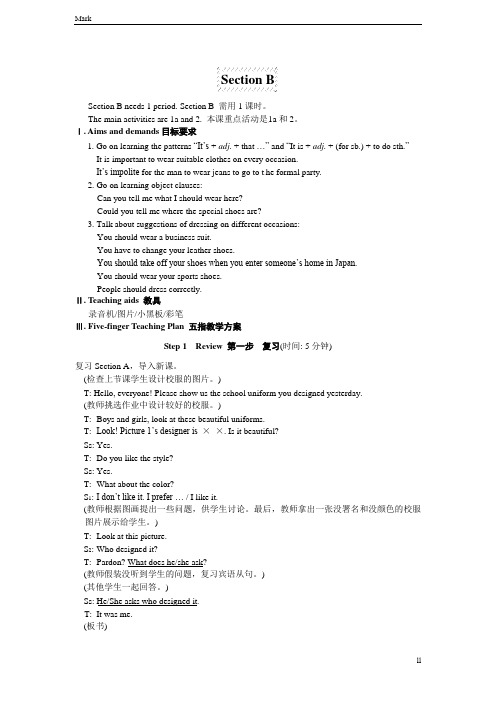
Section BSection B needs 1 period. Section B 需用1课时。
The main activities are 1a and 2. 本课重点活动是1a和2。
Ⅰ. Aims and demands目标要求1. Go on learning the patterns “It’s + adj. + that …” and “It is + adj. + (for sb.) + to do sth.”It is important to wear suitable clothes on every occasion.It’s impolite for the man to wear jeans to go to t he formal party.2. Go on learning object clauses:Can you tell me what I should wear here?Could you tell me where the special shoes are?3. Talk about suggestions of dressing on different occasions:You should wear a business suit.You have to change your leather shoes.You should take off your shoes when you enter someone’s home in Japan.You should wear your sports shoes.People should dress correctly.Ⅱ. Teaching aids 教具录音机/图片/小黑板/彩笔Ⅲ. Five-finger Teaching Plan 五指教学方案Step 1 Review 第一步复习(时间: 5分钟)复习Section A,导入新课。
仁爱版八下英语优质课教案 Unit 8 Topic 2 Section B
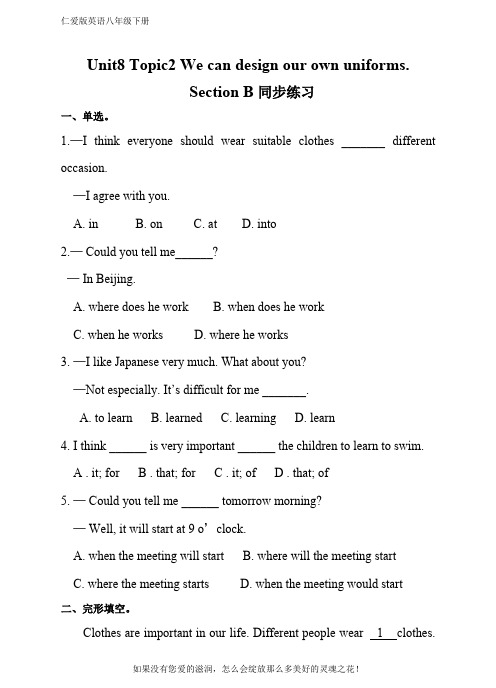
Unit8 Topic2 We can design our own uniforms.Section B同步练习一、单选。
1.—I think everyone should wear suitable clothes _______ different occasion.—I agree with you.A. inB. onC. atD. into2.— Could you tell me______?— In Beijing.A. where does he workB. when does he workC. when he worksD. where he works3. —I like Japanese very much. What about you?—Not especially. It’s difficult for me _______.A. to learnB. learnedC. learningD. learn4. I think ______ is very important ______ the children to learn to swim.A . it; forB . that; forC . it; ofD . that; of5. — Could you tell me ______ tomorrow morning?— Well, it will start at 9 o’clock.A. when the meeting will startB. where will the meeting startC. where the meeting startsD. when the meeting would start二、完形填空。
Clothes are important in our life. Different people wear 1 clothes.Now let's 2 some people talking about clothes.Hello, my name is Betty. I started working this year, so I'm able to get new clothes more often 3 before. There are different people in my working place every day. If someone sees me in 4 once, I don't like to go out in it again. I like to wear bright colors and always dress up when I go to parties. I buy all kinds of clothes and I try to follow the latest way of 5 .Hi, I'm Jack. I don't have much to say about clothes. Shopping 6 clothes isn't really the way of life I’m interested in. Since I'm still at college, I don't really mind 7 I wear. I have two jackets and I often wear 8 . I know little about the way of dressing. I don't like the serious look.My name is Alice. I'd like to say that my clothes have to be comfortable and make me 9 easy as soon as I put them on. Sometimes I buy clothes in some small markets—they're less expensive there. I go shopping for clothes about once a month. If I see 10 and fit for me, I would maybe go for it there.(1)A . the same B . different C . beautiful D . comfortable (2)A . listen to B . hear C . to listen to D . to hear(3)A . as B . like C . than D . long(4)A . something B . anything C . nothing D . everything(5)A . dress B . dressing C . dresses D . to dress(6)A . of B . in C . for D . on(7)A . what B . who C . where D . when(8)A . it B . them C . their D . they(9)A . to fee l B . feels C . feeling D . feel(10)A. something comfortable B. anything comfortableC. comfortable somethingD. comfortable anything三、阅读。
仁爱版英语八年级下Unit8-Topic2-Section-B参考教案
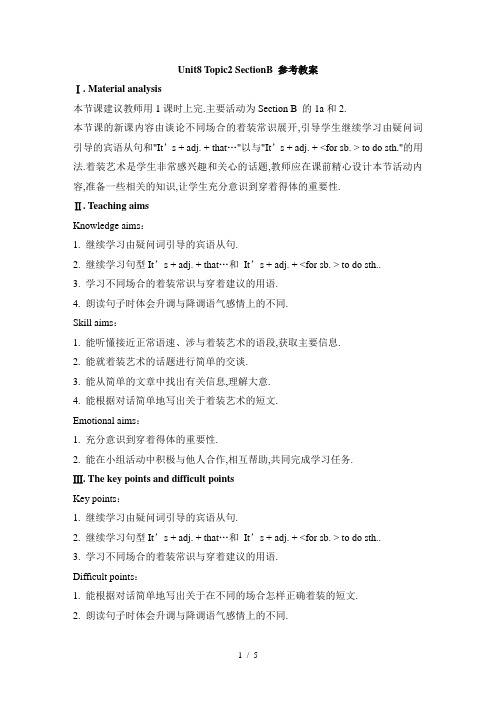
Unit8 Topic2 SectionB 参考教案Ⅰ. Material analysis本节课建议教师用1课时上完.主要活动为Section B 的1a和2.本节课的新课内容由谈论不同场合的着装常识展开,引导学生继续学习由疑问词引导的宾语从句和"It’s + adj. + that…"以与"It’s + adj. + <for sb. > to do sth."的用法.着装艺术是学生非常感兴趣和关心的话题,教师应在课前精心设计本节活动内容,准备一些相关的知识,让学生充分意识到穿着得体的重要性.Ⅱ. Teaching aimsKnowledge aims:1. 继续学习由疑问词引导的宾语从句.2. 继续学习句型It’s + adj. + that…和It’s + adj. + <for sb. > to do sth..3. 学习不同场合的着装常识与穿着建议的用语.4. 朗读句子时体会升调与降调语气感情上的不同.Skill aims:1. 能听懂接近正常语速、涉与着装艺术的语段,获取主要信息.2. 能就着装艺术的话题进行简单的交谈.3. 能从简单的文章中找出有关信息,理解大意.4. 能根据对话简单地写出关于着装艺术的短文.Emotional aims:1. 充分意识到穿着得体的重要性.2. 能在小组活动中积极与他人合作,相互帮助,共同完成学习任务.Ⅲ. The key points and difficult pointsKey points:1. 继续学习由疑问词引导的宾语从句.2. 继续学习句型It’s + adj. + that…和It’s + adj. + <for sb. > to do sth..3. 学习不同场合的着装常识与穿着建议的用语.Difficult points:1. 能根据对话简单地写出关于在不同的场合怎样正确着装的短文.2. 朗读句子时体会升调与降调语气感情上的不同.Ⅳ. Learning strategies1. 朗读时用降调表示命令的语气,用升调表示更有礼貌的请求.2. 体会句子中运用特定的句式进行某一内容的强调.3. 注意借助音像资料丰富自己的学习.Ⅴ. Teaching aidsputer multimedia projector; the videos about the activities in different occasions: having a meeting, having a party, doing sports, having a class and so on; the picture of attendants; The teacher should wear a suit for the class.Ⅵ. Teaching proceduresIntroduction〔8 minutes〕1. Greet students and make them ready for learning.2. The teacher lets students play the game "Pardon?" to review the usage of object clauses. Let them play the game in groups of three. They may change their roles one another.A: <speak out a wh-question>B: Can you tell me what A asks?C: She / He asks …3. The teacher lets students show the pictures of school uniforms designed by themselves. They can add the colors, the materials, and even the reasons of designing.4. The teacher lets students read the passage about the importance of some uniforms which they finished before class.5. The teacher evaluates their work and leads to new lesson by playing the videos about the activities on different occasions: having a meeting, having a party, doing sports, having a class and so on: It’s important to wear suitable clothes. I must wear a suit when I have the class, while you must wear school uniforms. We should wear different clothes correctly on different occasions.Presentation<10 minutes>1. The teacher lets students look at Picture 1 of 1a and lets them discuss what the man should wear on this kind of occasion.2. The teacher plays the first flash of 1a and lets the students watch and check theirdiscussion. Let them know about the meaning of gatekeeper by showing gate + keeper →gatekeeper. Teach the word suit by pointing at the teacher’s clothes.3. The teacher lets students learn different dressings on the other three occasions in the same way. Teach the new words after watching and checking. Teach attendant by show the pictures of attendants on the screen. Teach take off by putting on a hat and then taking it off. Teach knee by pointing at the knee of himself or herself. Explain the meanings of enter.4. The teacher plays the flash of the conversation between Jane and Maria. Let students watch it and find out the opinions of them.5. The teacher asks two students to tell the answers. Explain the meanings of occasion and correctly to them.Consolidation<10 minutes>1. The teacher plays the recording sentence by sentence.2. The teacher plays the recording without stopping.3. The teacher asks students to read the sentences in 1b and mark T <True> or F <False>.4. The teacher asks two students to tell the answers.5. The teacher lets students read the passage in 1c. Let them understand the meaning of this passage, and try pleting the passage.6. The teacher asks students to read the conversation of 1a and lets them check the blanks they have filled.7. The teacher asks two students to tell the answers.8. The teacher lets students read 1a and find out the sentences about object clauses with wh-questions and the sentences giving suggestions.9. The teacher asks two students to tell the answers. Write them on the blackboard. Stress the order of object clauses with wh-questions.10. The teacher lets students read 1a in roles and perform short plays in pairs. <Each pair may just play one short play.>Practice<10 minutes>1. The teacher lets students read 1a and find out the sentences of It’s + adj. + <forsb. > to do sth.2. The teacher asks two s tudents to tell the answers: It’s important to wear suitable clothes on every occasion. Guide students to change it to It’s + adj. + that …<It’s important that we wear suitable clothes on every occasion.>3. The teacher lets studentsobserve the pictures of 2 and read the given words, the phrases and the example.4. The teacher asks students to make sentences with the structures It’s + adj. + <for sb. > to do sth. and It’s + adj. + that …, using the given words and phrases according to the pictures.5. The teacher asks four students from different groups to write down the sentences on the blackboard. Student A writes the sentence according to Picture 1…6. The teacher asks one or two students to check the sentences on the blackboard. Give them a hand if necessary.7. The teacher plays the recording of 3 after they read the sentences by themselves.Let students listen and check their intonation.8. The eacher plays the recording of 3 again, and lets the students listen and try to imitate.Production<7 minutes>1. The teacher asks the students to discuss in groups about how to dress correctly on different occasions. Teacher had better help them set certain situations, such as going to a formal party, going to the movies or going out to do some exercise.Help them design a table and ask them to finish the table after discussing.Activities What to weargo to a partygo to the moviesdo exercise2. The teacher asks students to write a passage according to the result of the discussion above. Then report i t to the class. Remind them to use the structures: It’s important …, You should/ had better/ have to ….3. The teacher shows the summary of this section to the students.4. The teacher assigns homework:<1> Review the summary after class.<2> Collect some information about how to dress correctly on different occasions.<3> Make five sentences with the following structures:It’s + adj. + that … or It’s + adj. + <for sb.> to do sth.Teaching ReflectionTeacher may let students prepare some clothes before class if possible, they will do better in the performances of the four brief conversations. The teacher can set more certain situations and let the students discuss the suitable clothes they should wear in those occasions.Ⅶ. Blackboard designUnit 8 Our ClothesTopic 2 We can design our own uniforms.Section B1. gate + keeper →gatekeeper2. take off →put on3. correct →correctly4. It’s important to wear suitable clothes on every occasion. →It’s important that we wear suitable clothes on every occasion.Object clauses with wh-questions:Can you tell me what I should wear here?Could you tell me where the special shoes are?Sentences giving suggestions:You should wear a business suit.You have to change your leather shoes.You should take off your shoe s when you enter someone’s home in Japan.You should wear your sports clothes.People should dress correctly.。
仁爱版英语八年级下册Unit8Topic2SectionB优秀教学案例
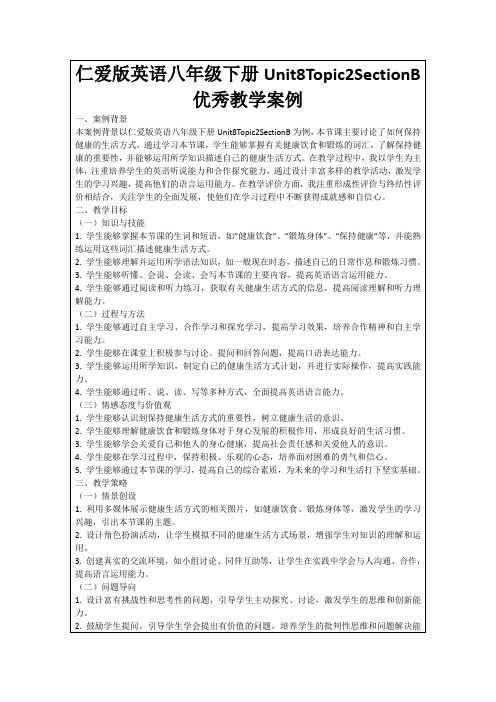
(一)知识与技能
1.学生能够掌握本节课的生词和短语,如“健康饮食”、“锻炼身体”、“保持健康”等,并能熟练运用这些词汇描述健康生活方式。
2.学生能够理解并运用所学语法知识,如一般现在时态,描述自己的日常作息和锻炼习惯。
3.学生能够听懂、会说、会读、会写本节课的主要内容,提高英语语言运用能力。
2.运用多媒体展示健康生活方式的视频资料,让学生直观地感受健康生活方式的重要性。
3.讲解一般现在时态的用法,并通过例句和练习,帮助学生掌握一般现在时态的构成和用法。
4.设计听力练习,让学生听懂、理解有关健康生活方式的对话或短文。
(三)学生小组讨论
1.设计讨论话题:“你们认为什么样的生活方式是健康的?请结合自己的生活实际,谈谈你们的看法。”让学生在小组内进行讨论。
5.作业小结:教师设计了富有思考性和实践性的作业,让学生在完成作业的过程中,运用所学知识,提高自己的语言运用能力。同时,作业小结也使学生能够及时发现自己的不足,进行自我调整和提高。此外,教师对学生的作业进行了及时批改和反馈,关注了学生的学习进步,激发了学生的学习动力。
3.创建真实的交流环境,如小组讨论、同伴互助等,让学生在实践中学会与人沟通、合作,提高语言运用能力。
(二)问题导向
1.设计富有挑战性和思考性的问题,引导学生主动探究、讨论,激发学生的思维和创新能力。
2.鼓励学生提问,引导学生学会提出有价值的问题,培养学生的批判性思维和问题解决能力。
3.通过问题引导学生深入思考健康生活方式对身心发展的影响,使学生在解决问题的过程中,形成正确的价值观。
五、案例亮点
1.情景创设:本节课通过展示图片、视频等多媒体资料,以及设计角色扮演活动,为学生创造了生动、真实的学习情境,使学生在实践中学会与人沟通、合作,提高了语言运用能力。
【新】仁爱版八年级英语下册Unit8 Topic 2 SectionB优质课课件.ppt

knee occasion
正确的,精确的
correctly
脱下,摘掉
take off
用所给词的适当形式填空 •It’s important that people should dress__c_o_rr_e_c_tl_y_(correct) on every occasion. •You should knock on the door before_e_n_te_r_in_g (enter)someone’s room in China. 3.He went down his_k_n_e_e_s_(knee)to sweep the floor. 4.It’s important to say different words on different_o_c_c_a_s_io_n_s__(occasion).
( F) ( T) ( T) ( F)
1c Read 1a and complete the passage.
It's impolite for the man to wear jeans to go to the formal meeting. So the gatekeeper tells him what__h_e__s_h_o_u_ld__w_e_a_r__. In the gym, the customer asks the attendant where she can __c_h_a_n_g_e__ her leather shoes. And we know it's polite to ___ta_k__e_o_f_f____ our shoes before entering someone's home in Japan. In the last picture,we see it's necessary for us to wear sports clothes and sports shoes on the playground,or we may__h__u_r_t __ ourselves as Kangkang did. So we should dress __c_o_r_r_e_c_tl_y__ on every accasion.
八年级英语仁爱版下册_Unit8_Topic2_SectionC_优质课课件
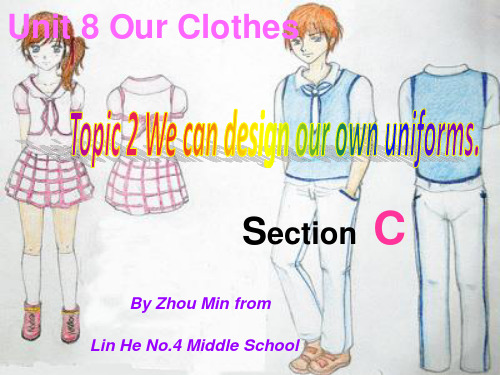
eyes __f_r_o_m___the sun.
读后抓巩固
3.当我们在机场看见航空公司飞行员穿着制服时, 我们相信他们知道怎样驾驶飞机。
When we __se_e__airline pilots __w_e_a_r_in__g_ uniforms at the airport, we believe that they know __h_o_w__t_o____/_h_o_w__t_h_e_y_c_a_n__fl_y_ fly the plane. 4. 所以对于我们来说了解日常生活中的不同制服
Read and pay attention to the pronunciation and intonation. (朗读能力需加强)
读后抓巩固
1.消防人员穿特殊服装和戴头盔是为了保护他们自 己免受高温和坠落的天花板的伤害。
Firefighters wear special coats and helmets
magazine?
2. Because they can protect themselves from
2h.eWathaynddofafilrleinfigghcteeirlisnwgsea.r special coats and helmets?
33..WWheaktncoanwwweekcnaonwgieftwheelspeefraompohliicme oofrfihceerr. in uniform?
是有必要的。
So it's _n_e_c_e_ss_a_r_y_ for us ____to__k_n_o_w______ different uniforms ___i_n_o_u_r__d_a_il_y_l_i_fe___ficial uniforms
【新】仁爱版八年级英语下册Unit8 Topic 2 SectionB优质课课件
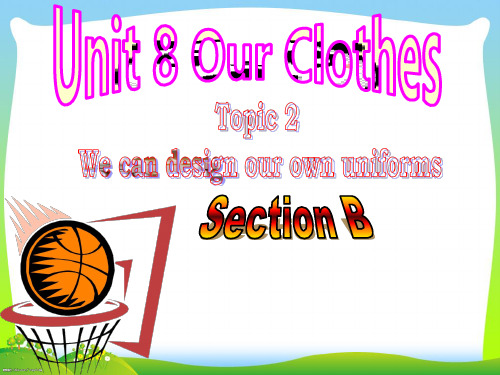
3.The patterns It’s + adj. + that …and It is + adj. + (for sb.) + to
— Well, it will start at 9 o’clock.
A. when the meeting will start B. where will the meeting start
C. where the meeting starts D. when the meeting would start
自学指导3
自学内容:课本P91 1a 自学方法:精读
自学时间:8分钟 自学要求:找出1a 中的重点短语和句子
自学指导3
自学内容:P92 Part 2。 自学方法:同桌讨论总结 自学时间:5分钟 自学要求:通过自学能够自己总结句型
It is + adj.+that... It is +adj.+(for sb.) + to
do sth. It is important to wear suitable clothes on every occasion. It’s impolite for the man to wear jeans to go to the formal
party. It's suitable that we wear business suits in a meeting. ◆Talk about suggestions of dressing on different occasions: You should wear a business suit. You have to change your leather shoes. You should take off your shoes when you enter someone’s home in Japan. You should wear your sports clothes. People should dress correctly.
【最新】仁爱版八年级英语下册Unit8 Topic2 ectionB精品课件.ppt
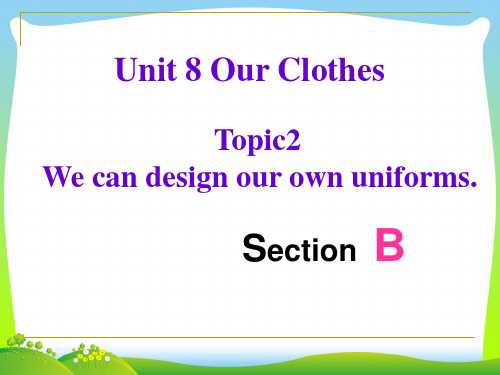
n.特别的事情(或仪式,庆典);时机
We should dress correctly on every occasion.
adv.正确地,精确地
1
2
3
1.It’s impolite for a student to wear a hat in class.
I think he should take off his hat in class.
Gatekeeper: You should wear a business suit.
Attendant: Sorry, madam. You have to change your leather shoes. Customer: Oh, sorry. Could you tell me where the special shoes are? Attendant: This way, please.
( F) ( T) ( T) ( F)
1c Read 1a and complete the passage.
It's impolite for the man to wear jeans to go to the formal meeting. So the gatekeeper tells him what__h_e__s_h_o_u_ld__w_e_a_r__. In the gym, the customer asks the attendant where she can __c_h_a_n_g_e__ her leather shoes. And we know it's polite to ___t_ak_e__o_ff_____ our shoes before entering someone's home in Japan. In the last picture,we see it's necessary for us to wear sports clothes and sports shoes on the playground,or we may___h_u_rt___ ourselves as Kangkang did. So we should dress __c_o_r_r_e_ct_l_y__ on every accasion.
【省级公开课教案】仁爱八下Unit8 topic 2 sectionB教学设计

(一)教学重点:
(1)Talk about suggestions of dressing on different occasions.
(2)Continue to learnthe object clause with what and where.
(3)Use “It’s+adj+that…”and “It’s+adj+(for sb)to dosth”to make sentences
Activity
What to wear
attend a party
do some exercise
...
…
发挥小组合作学习的力量,训练学生学以致用的能力
Step6 Summary
1.Summary
Encourage the Ss to summarize the important points together.
Unit8Topic2SectionB教学设计
I.学习目标
1. Learn some new wordsand phrases.
2. Talk about suggestions of dressing on different occasions:
3.Continue to learnthe object clausewith what and whereand use“It’s+adj+that…”and “It’s+adj+(for sb)to dosth”to make new sentences.
通过对1a的跟读训练并进行角色演练。培养学生自主学习的能力与团队合作学习的默契。
读1a将对话变成小短文。锻炼读写能力。
【最新】仁爱版八年级英语下册Unit 8 Topic 2 Section D优质课课件.ppt

班时通常也穿西服。
as well as 还有,除......之外(也)。置于句中。 E.g:他们在城里有一栋房子,在乡下还有一座别墅。 They own a house in the city as well as a villa in the countryside.
Example:
I usually wear a T-shirt,shorts and sports shoes to school because I like doing sports. But my favorite clothing is a shirt with a tie because it makes me look handsome.On special days I usually wear new clothes that I like. What about you? Could you tell me?
Suits. 6.Do people in cities all over the world wear similar clothes?
Yes, they do.
英【译汉自:学检测3】
•in north America •depends on •on birthdays •formal occasions
You may want to know what people in North America wear to work and on special days. In fact, they have very few formal days, though there are some festivals such as Easter, Christmas, Halloween and Thanksgiving Day. What people wear depends on their likes and dislikes. On birthdays, some children wear paper party hats. At Christmas, some people wear Santa Claus hats. In winter, Canadian people wear coats, gloves, boots and hats the same as people in northern China do. People in Canada and the United States usually wear suits to work in offices, as well as for more formal occasions, just as people do in China. People in cities around the world wear quite similar clothes.
仁爱版八年级英语下Unit8 Topic 2 SectionB 课件
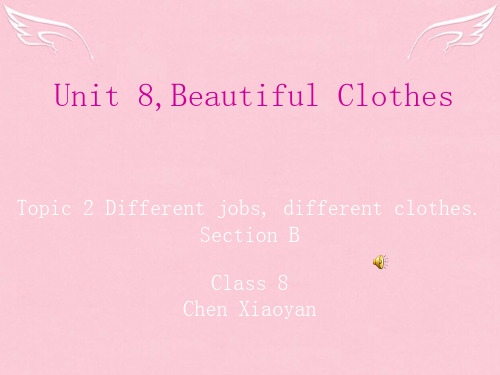
obey the traffic rules
It’s necessary that everyone obeys the traffic rules.
be famous
It’s true that the Great Wall is famous in the world.
Listen and choose.(3)
Task 4 找出1b中所有的从句
• 宾语从句 1,The gatekeeper tells him what he should wear. 2,The customer asks the server where he can change his shoes. 3,we know it’s polilte that we take off our shoes before entering someone’s home in Japan. 4,we see it’s necessary that you wear sports shoes on the playground. • 主语从句 1,It’s important that the man wears jeans to go to the formal party. 2,it’s polite that we take off our shoes before entering someone’s home in Japan. 3,it’s necessary that you wear sports shoes on the playgruond.
Unit 8,Beautiful Clothes
Topic 2 Different jobs, different clothes. Section B Class 8 Chen Xiaoyan
仁爱版英语八年级下Unit8-Topic2-Section-B参考教案-学习文档
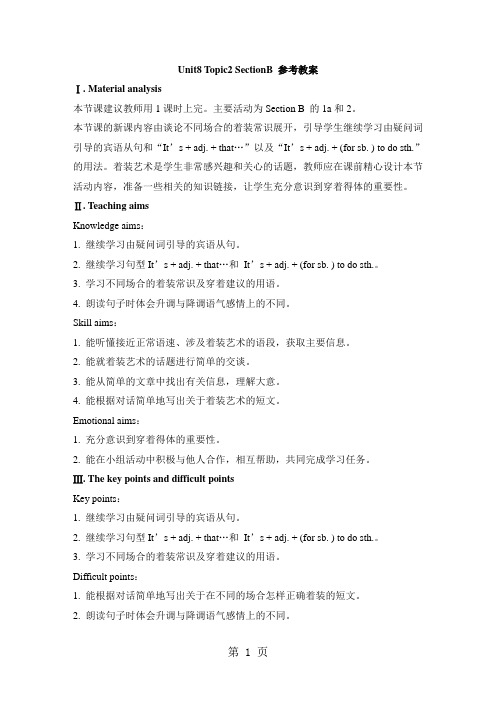
Unit8 Topic2 SectionB 参考教案Ⅰ. Material analysis本节课建议教师用1课时上完。
主要活动为Section B 的1a和2。
本节课的新课内容由谈论不同场合的着装常识展开,引导学生继续学习由疑问词引导的宾语从句和“It’s + adj. + that…”以及“It’s + adj. + (for sb. ) to do sth.”的用法。
着装艺术是学生非常感兴趣和关心的话题,教师应在课前精心设计本节活动内容,准备一些相关的知识链接,让学生充分意识到穿着得体的重要性。
Ⅱ. Teaching aimsKnowledge aims:1. 继续学习由疑问词引导的宾语从句。
2. 继续学习句型It’s + adj. + that…和It’s + adj. + (for sb. ) to do sth.。
3. 学习不同场合的着装常识及穿着建议的用语。
4. 朗读句子时体会升调与降调语气感情上的不同。
Skill aims:1. 能听懂接近正常语速、涉及着装艺术的语段,获取主要信息。
2. 能就着装艺术的话题进行简单的交谈。
3. 能从简单的文章中找出有关信息,理解大意。
4. 能根据对话简单地写出关于着装艺术的短文。
Emotional aims:1. 充分意识到穿着得体的重要性。
2. 能在小组活动中积极与他人合作,相互帮助,共同完成学习任务。
Ⅲ. The key points and difficult pointsKey points:1. 继续学习由疑问词引导的宾语从句。
2. 继续学习句型It’s + adj. + that…和It’s + adj. + (for sb. ) to do sth.。
3. 学习不同场合的着装常识及穿着建议的用语。
Difficult points:1. 能根据对话简单地写出关于在不同的场合怎样正确着装的短文。
2. 朗读句子时体会升调与降调语气感情上的不同。
- 1、下载文档前请自行甄别文档内容的完整性,平台不提供额外的编辑、内容补充、找答案等附加服务。
- 2、"仅部分预览"的文档,不可在线预览部分如存在完整性等问题,可反馈申请退款(可完整预览的文档不适用该条件!)。
- 3、如文档侵犯您的权益,请联系客服反馈,我们会尽快为您处理(人工客服工作时间:9:00-18:30)。
自学检测三
2 Make sentences with the following information,
using It's +adj.+(for sb.) to do sth. or It's +adj.+that...
necessary suitable important right
学习目标
1、能正确会读,说出、写出P91-92的生词, 并能进行英汉互译.
2、熟读1a,完成1b,1c.能够说出1a的知识点, 并能正确运用,正确做题。
3、学习掌握句型 It is + adj.+that... It is +adj.+(for sb.) + to do... 并能正确运用。
自学指导1
wear business suits
keep quiet
2
isten to the teacher
It's necessary/important/right that we keep quiet in the hospital. It's necessary/important/right (for us) to keep quiet in the hospital.
自学指导3
自学内容:课本P91 1a 自学方法:精读
自学时间:8分钟 自学要求:找出1a 中的重点短语和句子
自学指导3
自学内容:P92 Part 2。 自学方法:同桌讨论总结 自学时间:5分钟 自学要求:通过自学能够自己总结句型
It is + adj.+that... It is +adj.+(for sb.) + to
( F) ( T) ( T) ( F)
1c Read 1a and complete the passage.
It's impolite for the man to wear jeans to go to the formal meeting. So the gatekeeper tells him what__h_e__s_h_o_u_ld__w_e_a_r__. In the gym, the customer asks the attendant where she can __c_h_a_n_g_e__ her leather shoes. And we know it's polite to ___ta_k__e_o_f_f____ our shoes before entering someone's home in Japan. In the last picture,we see it's necessary for us to wear sports clothes and sports shoes on the playground,or we may__h__u_r_t __ ourselves as Kangkang did. So we should dress __c_o_r_r_e_c_tl_y__ on every accasion.
knee occasion
正确的,精确的
correctly
脱下,摘掉
take off
用所给词的适当形式填空 •It’s important that people should dress__c_o_rr_e_c_tl_y_(correct) on every occasion. •You should knock on the door before_e_n_te_r_in_g (enter)someone’s room in China. 3.He went down his_k_n_e_e_s_(knee)to sweep the floor. 4.It’s important to say different words on different_o_c_c_a_s_io_n_s__(occasion).
自学指导2
自学内容:课本99页1a 自学方法:听录音和扫读。 自学时间:5分钟 自学要求:听1a,完成1b; 读1a,完成1c.
自学检测二
1b Listen to 1a and Mark T(True) or F(False).
1.The gatekeeper asks the man to wear jeans there. 2.The customer wants to know where to find the special shoes. 3.The daughter will take her shoes off when entering a Japanese home. 4.Kangkang hurts his knees because he does too much sports.
It's necessary/important that they/the students listen to the teacher carefully in class. It's necessary/important (for them/the students) to listen to the teacher carefully in class.
1.自学内容:P91-92的生词。 2.自学方法:先根据音标试读,同桌互相正 音,提问。 3.自学时间:5分钟 4.自学要求:会读,知道其汉语意思,并能 英汉互译。
自学检测1 英汉互译
门卫
gatekeeper
套装,适合
பைடு நூலகம்
suit
服务员,侍者
attendant
进去,进入,加入
enter
膝盖,膝关节 特别的事情,时机
Besides voice,special sentence structure is an effective way to stress.
Example: It's suitable (for us ) to wear business suits in a meeting. It's suitable that we wear business suits in a meeting.
